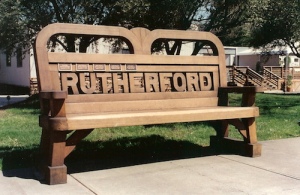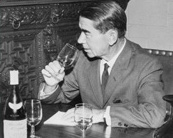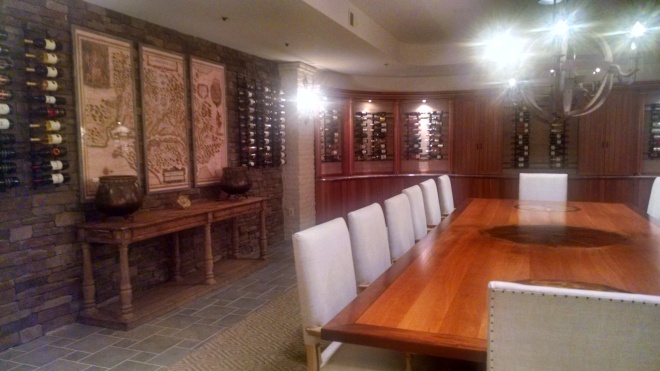Shortly after joining Beaulieu Vineyard in 1938, Russian-born/French-trained head winemaker André Tchelistcheff was heard to say that no wine from this prime slice of Napa Valley could be considered great unless it had a touch of “Rutherford dust.” Tchelistcheff went on to make wine at BV for 35 years, trained and influenced multiple generations of Napa winemakers, and earned the titles “Dean of American Wine” and “Maestro” from his disciples and peers. But few things he did or said have provoked as much discussion or confusion as Rutherford dust.
Start with the basics. Brothers Georges and Fernande de Latour arrived in Napa Valley in 1903 in search of a vineyard. When they reached the prune and apple orchards around the tiny village of Rutherford, Fernande exclaimed “beau lieu!” – beautiful place. They purchased a small ranch, adopted Beaulieu as the name for their new vineyard, and set about assembling what would reach 500 acres of land on and around what came to be called the Rutherford bench.
Rutherford lies in the middle of the Valley as it runs south to north, far enough south to benefit from cool maritime air at night but far enough north to get plenty of heat and sunshine. It’s at the widest part of the Valley, so it gets more hours of sun each day than vineyards more shaded by the mountains to east and west.
 And, importantly, its vineyards are planted on free-draining, alluvial soils – a deep blend of gravel, sand, silt and clay that rests on the rocky base of the old Napa River. Some argue that the best of these soils run on a slight rise from Oakville to St. Helena and call them the Rutherford Bench. Others say that the only Rutherford Bench is the one you can sit on in front of the Oakville General Store. In any event, these dry, loose, often wind-blown (and, thus, dusty) soils are a fantastic place to grow Cabernet Sauvignon
And, importantly, its vineyards are planted on free-draining, alluvial soils – a deep blend of gravel, sand, silt and clay that rests on the rocky base of the old Napa River. Some argue that the best of these soils run on a slight rise from Oakville to St. Helena and call them the Rutherford Bench. Others say that the only Rutherford Bench is the one you can sit on in front of the Oakville General Store. In any event, these dry, loose, often wind-blown (and, thus, dusty) soils are a fantastic place to grow Cabernet Sauvignon
What Is Rutherford Dust? Ask most Napa winemakers to describe “Rutherford dust,” and many talk about things like minerality (a kind of stony/chalky note), or a ground spice character that many liken to just-grated allspice. And, even more will call out how Rutherford Cabernet – especially lower alcohol wines from times before the current emphasis on super-ripeness – leave behind tannins so firm and fine that they remind you of cocoa powder – or the finest of wind blown dust.
As it happens, you’ll find those cocoa powder tannins – fine, dusty, and so ripe they melt away easily – in both of today’s Beaulieu wines along with a dash of minerality and even a little grated allspice (in the Georges de Latour, anyway). But, dusty tannins weren’t actually what Tchelistcheff meant.
Having trained in France and drunk the greatest wines of Bordeaux, Burgundy and beyond, Tchelistcheff believed that the first duty of every great wine was to represent the place where it was grown. And, for Rutherford wines, that meant showing the tantalizing balance between warm, even hot, days and cool, foggy, nights. It meant showing fine ripeness of fruit and a touch of fresh herb, but neither the stewy, roasted flavors of hotter vineyards up-Valley or the colder regions to the south. And, because Tchelistcheff believed Rutherford was a great Cabernet vineyard, it meant that any wine wanting to claim “Rutherford” on the label had to be great, too.
In trying to say all of that, he drew on the most distinctive element of 1930s Rutherford: the fine, reddish, dust that blew up off the vineyards and got onto and into everything (hopefully not including the wine!).
 Beaulieu is Back! After establishing Rutherford as a great Napa Cab site and joining Louis Martini, Inglenook and Charles Krug as a America’s foremost wineries from the end of Prohibition – the 1970s, BV’s quality sagged a bit in the 1980s and 1990s. Multiple changes in corporate ownership didn’t help, and having to replant virtually all of their Rutherford sites in the early 1990s due to phylloxera wasn’t an asset, either.
Beaulieu is Back! After establishing Rutherford as a great Napa Cab site and joining Louis Martini, Inglenook and Charles Krug as a America’s foremost wineries from the end of Prohibition – the 1970s, BV’s quality sagged a bit in the 1980s and 1990s. Multiple changes in corporate ownership didn’t help, and having to replant virtually all of their Rutherford sites in the early 1990s due to phylloxera wasn’t an asset, either.
Things got a little better after André Tchelistcheff returned as a consultant in 1991 (he’d retired in 1973). He pushed for lower yields in the new vineyards and helped BV make the transition from redwood fermentation tanks and American oak to stainless steel and French oak. But the winery’s focus on its value, supermarket, wines after Tchelistcheff’s death in 1994 left the fine wine program a bit adrift.
Fortunately, a new focus on quality emerged in the mid-2000s with the hiring of Bordeaux consulting superstar to work on the Georges de Latour Private Reserve program. As Robert Parker noticed in his reviews of the 2005 releases, “Michel Rolland, the brilliant wine consultant, was brought in to help resurrect the Private Reserve program, and it appears his magic has spilled over onto the other wines as well.”
Tasting these 2012s, you’ll be immediately struck by how the new BV is marrying the restrained, traditional, style that made the winery great with an increased emphasis on ripe fruit and supple, velvety, structures. Yes, you’ll find a little of that “Rutherford dust” cocoa powder texture to the tannins and a hint of grated allspice, too. But mainly you’ll love how both wines are so pure, textured, and fun to drink right now.
And, at these prices, a little gold dust is sprinkled in with the Rutherford dust, too.










